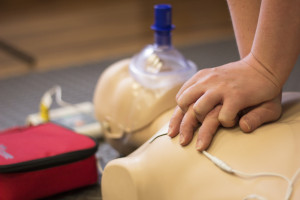CPR mistakes happen every day. You’ve completed your CPR training and you’re alert to the world around you, looking for people to help with your newfound knowledge. Suddenly without warning, an emergency arises and you need to act. Will you be able to perform your duties without any helpful reminders on the spot?
Here is a list of common CPR mistakes that people make and what to do to avoid making them yourself. If you know in advance what to avoid, you will be able to make good choices and have an impact on someone in distress.
-
Giving respiration (mouth to mouth) priority over chest compression :
- According to the latest research, giving chest compressions only to ADULTS is enough maintain a certain amount of gas exchange in the lungs if the mouth is open during compressions. So keep giving compression, respiration can wait. When an adult collapses into cardiac arrest in front of you we assume that they are fully oxygenated, so compressions only is helpful in getting that already oxygenated blood to the head and heart.
-
Being afraid to hurt the victim:
- Current CPR protocols call for pushing the chest down at least 2 inches at a rate of 100 to 120 compressions per minute for anyone over the age of 1. Keep in mind that the best job you can do during CPR only gives the patient 25% circulation. Not doing effective compression is not going to help a person in cardiac arrest. Push hard and fast.
-
Interrupting CPR to give respiratory support or attending minor injuries:
- Respiration can wait. A cut on the victim’s body is less important than compressions. Keep giving CPR until help arrives.
-
Not assessing the response:
- Unlike in the movies, victims don’t jump up and take a deep breath once they regain the pulse. You have to keep checking carotid (neck vessel) for appearance of pulsations.
-
Not calling for help:
- One of the biggest CPR mistakes you can make is not calling to make sure help is on the way. A normal person will not be able to give adequate CPR for more than 2 minutes. You should not be calling for help when you are about to give up. Calling for help should be a first priority before you even start CPR.
-
CPR is not everything:
- The victim may need other types of medical support. Even if the victim responds to CPR he/she will need medical help to sustain cardiac activity. Make sure help is one the way!
-
Forgetting your own safety:
- Especially in poisoning, drowning, electrocution and natural calamities. It’s important to take a look around and make sure that both you and the victim won’t sustain further injury.
-
Improper CPR Technique:
- One of the most common CPR mistakes made is using improper technique. Examples include too rapid compression, not keeping elbows straight, or giving too little force. These can be avoided by following the standard protocol learned in your training. It’s essential that you renew your certification every two years to stay on top of new techniques and information, and also to refresh your memory so you can effectively perform CPR.
Now that you know the most common CPR mistakes, it will be easy for you to remember what to do should you need to use your CPR skills. Staying calm, focused, and remembering your training will set you up for success in case of emergency!


